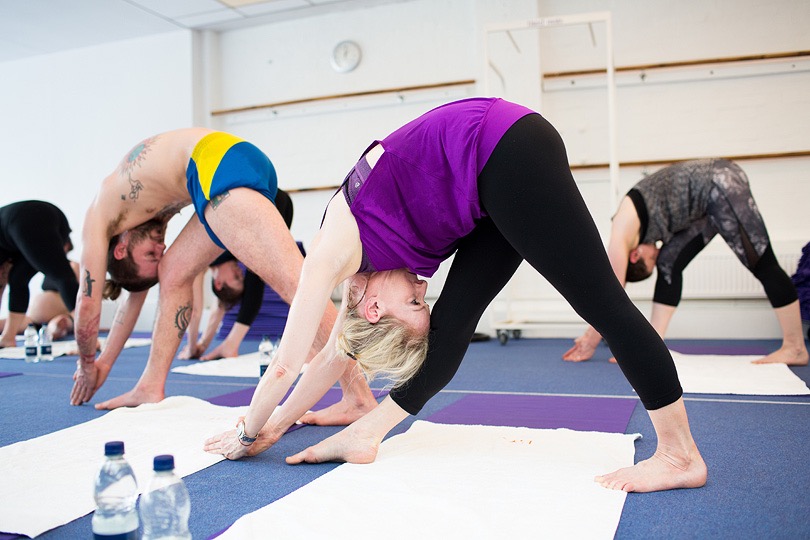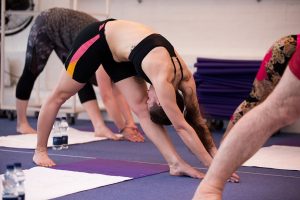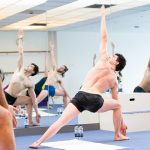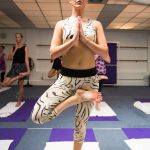Standing Seperate Leg Head to Knee Pose tips
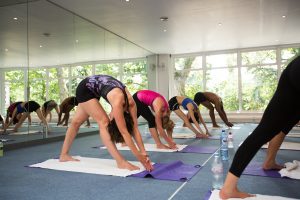 Triangle, is over, done, finished, you rocked it. Your reward is Standing Seperate Leg Head to Knee Pose (well that and the knowledge that in two more postures time you get a 2 minute savasana!)
Triangle, is over, done, finished, you rocked it. Your reward is Standing Seperate Leg Head to Knee Pose (well that and the knowledge that in two more postures time you get a 2 minute savasana!)
1 – Stand straight, feet together, and raise your arms over your head sideways, until your palms touch. Interlace your thumbs. Engage your arm muscles by pressing your palms together firmly and locking out your elbows. Arms should be by the ears throughout the posture, but make sure you do not bring your shoulders up to meet the ears!
2 – Step your right leg out about 3 feet distance. Obviously this distance is dependent on your height and leg length. It is a smaller step then triangle, roughly double you hip width.
3 – Enage your core.
4 – Pivot on your heels with your toes off of the floor, turn your entire body, feet to the finger tips 90 degrees to the right. Your heels should be in one line, one in front of the other, with the back foot at a 45 degree outward angle . To make sure your heels are in a straight line, try practising this posture on the edge of your mat or on the white lines down the BYC studio floor.
5 – Make sure your hips are in a straight line. You can have a little peek in the mirror to make sure one isn’t further forward and adjust yourself accordingly. As with all postures alignment is key so you may need to bounce your hips several times to get the correct position.
6 – Check your core is still enaged. On an exhale breath, tuck your chin to your chest, keeping your arms by your ears and curl down until your forhead touches your knee.
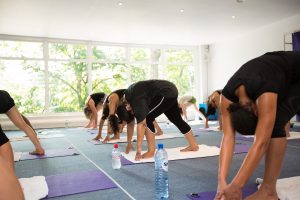 Beginners/Intermediate: You may need to bend your front knee to meet your forehead. It is more important to have the forehead to knee connection, than a straight leg. You will also find that as you come down you may need to separate your hands onto the floor, in front of your foot, for balance.
Beginners/Intermediate: You may need to bend your front knee to meet your forehead. It is more important to have the forehead to knee connection, than a straight leg. You will also find that as you come down you may need to separate your hands onto the floor, in front of your foot, for balance.
Advanced: Try keeping your hands in prayer, the whole time and the front leg straight, locked out and engaged.
7 – Your hips might have fallen out of line. If so, re-adjust your weight moving more of it forward into your front foot. This should help move the hips into alignment. You may also need to move the left hip forward. Try to keep your back leg solid, locked out, heel on the gound.
8 – Beginners/Intermediate: Check that the core is still engaged. Push your hands into the floor and try to lock out the front leg, while keeping your forehead to the knee. Test your balance and see if you can try moving your hands back into prayer, wrists straight, arms locked out, finger tips pressing into the ground. If you are still unable to balance with your hands in prey try to cross your thumbs, fingures sprayed out pushing against the floor.
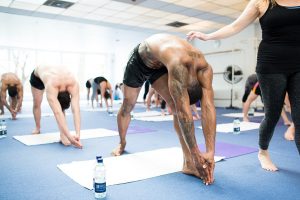 Advanced: Both legs are straight, keep the core engaged, arms locked out, hands in prayer, pressing your palms together, forehead to knee.
Advanced: Both legs are straight, keep the core engaged, arms locked out, hands in prayer, pressing your palms together, forehead to knee.Ground the outside edge of your back foot into the floor.
As an extra tip for stability, contract your thighs and squeeze the inner thighs together. Once you have this, just breathe, hold the posture. Less is more!
Keep your core/stomach muscles engaged throughout the posture.
11- Inhale breathing, round up, slowly and gently, keeping your arms glued to your head, roll your chin up last, untill your whole spine is straight.
12 – Pivot on your heels 180 degrees and do the whole thing on the other side. (Whenever I hear a teacher say ‘pivot’ in class, which is a lot, I am always reminded of this classic scene from Friends, so now you will be too, a little humour goes a long way!)
DANDAYAMANA-BIBHAKTAPADA-JANUSHIRASANA
Standing Separate Leg Head to Knee Pose
Standing Separate Leg Head to Knee Pose
Benefits:
May be good for depression and memory loss.
Reduces abdominal obesity.
Good for diabetic conditions.
Balances blood sugar levels.
Assists in regulating pancreas and kidneys.
Works endocrine, digestive and reproductive systems.


